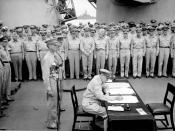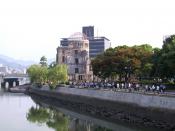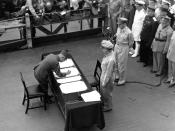3rd
The Decision to Drop the Atomic Bomb
Beginning in 1942 and continuing through 1945, the war in the Pacific was characterized by the intense bombing of the Japanese by the United States under President Roosevelt and later President Harry Truman. By August 6, 1945, with the end of war in Europe secured and the end in the Pacific in sight, "Little Boy," an enriched uranium bomb was dropped on the Japanese city of Hiroshima (Strategic Bombing during WW2). On August 9, 1945, only three days after the bombing of Hiroshima, the second atomic bomb, "Fat Man," was dropped over Nagasaki (Atomic Bombing of Hiroshima and Nagasaki). These two bombs, the only uses of nuclear weapons in warfare, had been the result of the $2 billion dollar Manhattan Project which was located in New Mexico (Manhattan Project). Both the physical and human loss as a result of these two bombs was vast.
Nearly 90% of Hiroshima and 45% of Nagasaki was destroyed, and the combined death toll was upwards of 225,000 as a result of the bombs and the subsequent radiation sickness. The Americans had to drop the bombs due to American animosity towards the Japanese, the potential millions of lives saved, and because the bombs prompted the unconditional surrender of Japan.
The dropping of the atomic bombs at Hiroshima and Nagasaki saved numerous American and Japanese lives by avoiding an invasion of the Japanese home islands. As the war progressed the Japanese war plan changed as defeat seemed inevitable. The Japanese followed a code of honor known as the Bushido code which presented war as purifying, surrender as disgraceful, and death for the Emperor as a duty (Japan: No Surrender). With Allied forces slowly "hopping" towards the home islands of Japan, the Japanese government looked...


